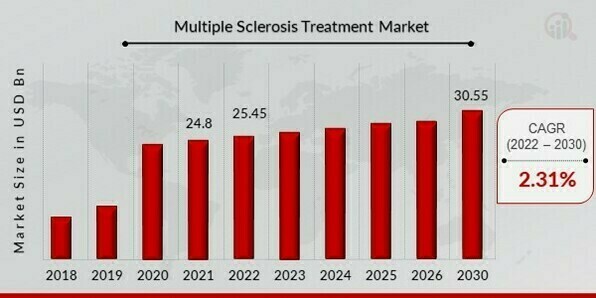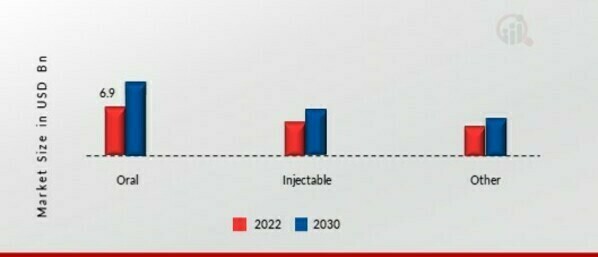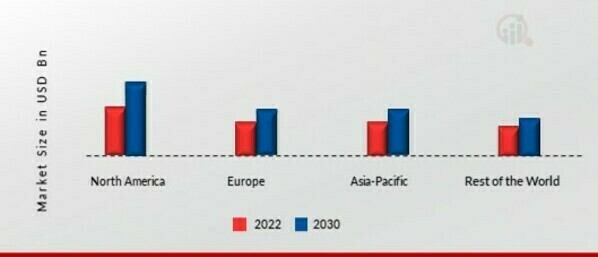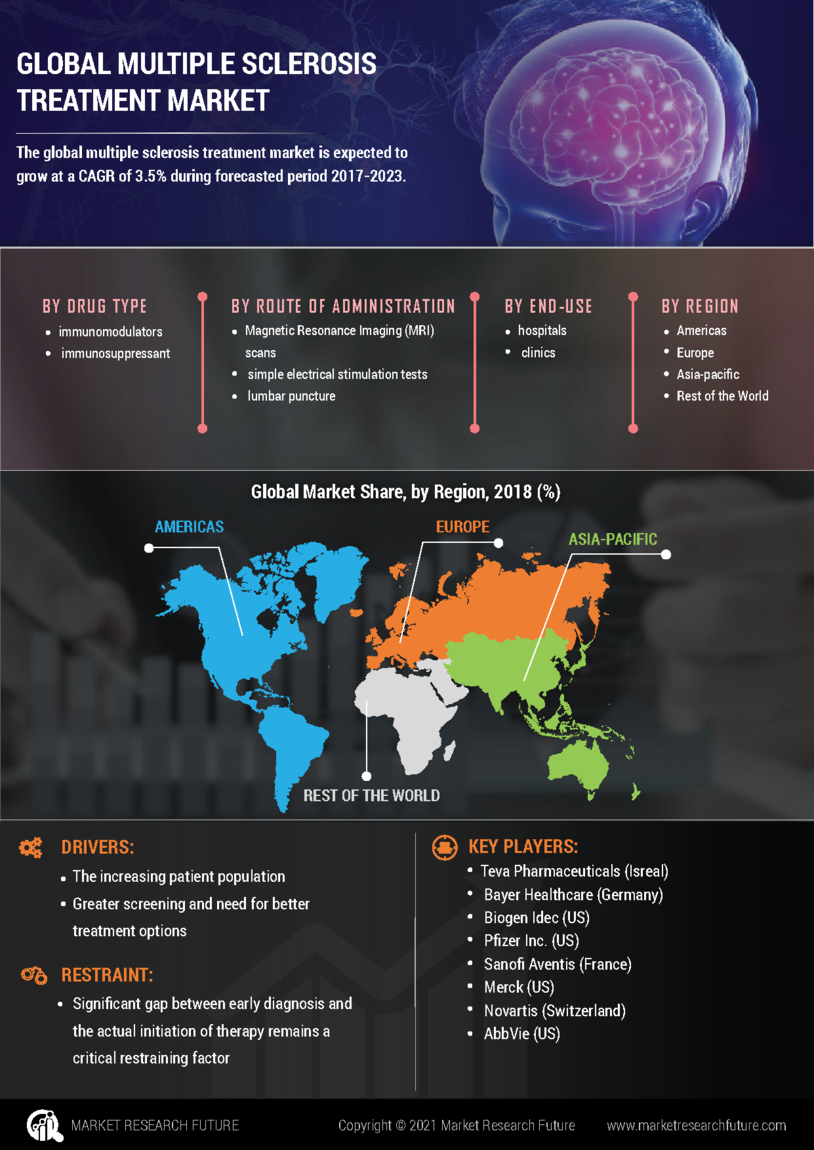Global Multiple Sclerosis Treatment Market Overview
Multiple Sclerosis Treatment Market size was valued at USD 24.8 Billion in 2021 and is projected to grow from USD 25.45 Billion in 2022 to USD 30.55 Billion by 2030, exhibiting a compound annual growth rate (CAGR) of 2.31% during the forecast period (2022 - 2030). Increasing patient population is the key market drivers enhancing market growth.
Source: Secondary Research, Primary Research, MRFR Database and Analyst Review
A condition involving the central nervous system, multiple sclerosis (MS) is immune-mediated. Demyelination, inflammation, degenerative processes like increasing brain and spinal cord atrophy, and neuroaxonal loss are its defining characteristics. Treatment for multiple sclerosis is currently using monoclonal antibodies more frequently. Utilizing these antibodies, numerous clinical studies are being conducted to create new multiple sclerosis medications. Additionally, most immunosuppressive medications used to treat this illness are humanized monoclonal antibodies, in higher demand globally. Globally, there is a greater need for multiple sclerosis diagnosis and treatment due to the disease's rising prevalence. Consequently, the government actively supports the multiple sclerosis therapeutic process. The body's immune system attacks the neurons in the central nervous system, causing myelin destruction. It is a condition that could be quite crippling and interfere with how well the body communicates and coordinates.
Multiple sclerosis symptoms can vary greatly depending on the degree of the damage and the number of damaged neurons. Fatigue, numbness, stiffness, urinary incontinence, cognitive problems, emotional disturbances, and sadness are a few of the symptoms that have been noted. The increased emphasis key market participants place on R&D to create novel medications is responsible for the rise of the multiple sclerosis drug industry. Along with increased research activity, there have also been numerous research agreements between pharmaceutical firms and academic institutes, which have helped the market for multiple sclerosis treatments even more. Pharmaceutical firms of all sizes have been expanding their potential product pipeline by researching new prospects. The shift in preference toward oral medications is another factor driving the growth of the global MS treatments market. Over the past ten years, research and development in neurological therapy have been ongoing. Multiple sclerosis is being treated using a variety of cutting-edge compounds. Some of the major pharmaceutical companies strongly emphasize the improvement of multiple sclerosis-related difficulties.
According to Rutgers University researchers, most people with multiple sclerosis, or MS, choose oral medications to treat their ongoing and deteriorating neurological disorders. This is presumably due to several factors, including consumer advertising, usability, and cooperation from insurance carriers. To assess trends in the uptake of treatments between 2000 and 2020 for patients with MS, an incurable and forward-thinking neurological disorder that is the primary cause of nontraumatic disability among adults of all ages, the study, released by JAMA Neurology, looked at an extensive and varied population of commercially insured adults as well as kids in the United States. They discovered that oral drugs quickly gained favor as an alternative to infusion and injectable therapies for MS patients.
Multiple Sclerosis Treatment Market Trends
- Significant R&D Investment to boost the market growth
Clinical research and R&D investments are attracting huge interest in the multiple sclerosis treatment market. MS is a disease that many pharmaceutical companies are attempting to treat. For instance, Pipeline Therapeutics is testing its PIPE-307, a selective antagonist of the M1 receptor, in clinical trials for multiple sclerosis. In addition to the increased research activities, many research collaborations have also been formed between pharmaceutical companies and research institutes, which has further favored the market of multiple sclerosis treatment. Pharmaceutical companies of all sizes have been strengthening their pipeline portfolio through increased research on novel candidates. Market growth of multiple sclerosis treatment is likely to be sparked by the launch of these pipeline candidates.
Increasing Prevalence of Multiple Sclerosis to boost the market growth
The rising prevalence of multiple sclerosis is a primary driver of the multiple sclerosis market's growths. Relapsing-remitting multiple sclerosis (RRMS), primary-progressive MS (PPMS), secondary-progressive MS (SPMS), and progressive-relapsing MS (PRMS) is the types of multiple sclerosis and their high prevalence rate will influence the market dynamics during the forecast period.
Multiple Sclerosis Treatment Market Segment Insights
Multiple Sclerosis Drug Type Insights
The market segment of multiple sclerosis treatment, based on drug type, includes Immunomodulators, and immunosuppressants. The Immunosuppressant segment held the majority share in 2021 of the Multiple Sclerosis Treatment market revenue. The immunosuppressants segment was the highest contributor to the market, owing to their beneficial effects for patients suffering from relapsing-remitting multiple sclerosis (RRMS) by weakening the immune system, thereby suppressing the autoimmune attack in the patient’s body and preventing relapses. In addition, the increase in product approvals for the treatment of MS therapies is anticipated to propel the market growth globally.
Multiple Sclerosis Treatment Type Insights
Based on the Route of Administration, the Multiple Sclerosis Treatment market segmentation includes Injectable, Oral, and Other. The oral route of administration segment dominated the market in 2021 and is projected to be the faster-growing segment during the forecast period, 2022-2030. Significant therapeutic advances in the new orally administered drugs approved for MS treatment represent a boost to the growth of the market. Three oral drugs have been approved by regulatory agencies for the treatment of MS, which include fingolimod, teriflunomide, and dimethyl fumarate. These all factors for Multiple Sclerosis Treatment positively impact the market growth.
Figure 2: Multiple Sclerosis Treatment Market, by route of administration, 2022 & 2030 (USD Million)
Source: Secondary Research, Primary Research, MRFR Database and Analyst Review
NewThe CHMP of the European Medicines Agency (EMA) has adopted a favorable opinion for marketing authorization for the first-of-its-kind biosimilar natalizumab created by Polpharma Biologics, according to Sandoz, an international pioneer in off-patent medications. In adults with very active relapses of multiple sclerosis (RRMS), the authorization includes medication as a single disease-modifying therapy (DMT), the same indication authorized by the EMA for the reference biologic.
Multiple Sclerosis Treatment Regional Insights
By region, the study provides market insights into North America, Europe, Asia-Pacific, and the Rest of the World. The Asia Pacific region's healthcare sector expands at a rapid pace, it is expected to have an increasing need for healthcare professionals. The multiple sclerosis treatment markets are likely to be dominated by China and India since both of their populations have a high number of people suffering from the disease. A major contribution to the growth of the Southeast Asian market will come from China, India, and Malaysia. There is an increase expected in multiple sclerosis diagnosis in Asian countries, specifically in the Asia Pacific region, due to the growing need for health care services. Asia-Pacific is expected to grow the fastest during the forecasted period. Multiple sclerosis is difficult to treat in Asia-Pacific due in large part to the large number of people suffering from deadly diseases. Hence, Asia-Pacific is anticipated to register the highest growth rate over the forecast period from 2022–2030.
Further, the major countries studied in the market report are The U.S., Canada, Germany, France, the UK, Italy, Spain, China, Japan, India, Australia, South Korea, and Brazil
Figure 3: MULTIPLE SCLEROSIS TREATMENT MARKET SHARE BY REGION 2022 (%)
Source: Secondary Research, Primary Research, MRFR Database and Analyst Review
Due to the growing healthcare industry and healthcare penetration in Europe, multiple sclerosis treatment is the second-largest market in the world. Germany and France lead the market growth of multiple sclerosis treatment in Europe. With its large pharmaceutical industry, Germany is expected to have the fastest growth over the assessment period. Several markets dominate the multiple sclerosis market, with Europe ranking second after the Asia Pacific. This is due to its investment in advanced technologies.
North America market of multiple sclerosis treatment is expected to reach USD 14.76 Billion at a CAGR of 6.76% by 2030, due to the rapid development of the medical sector in the United States and an increase in the number of research institutions for better treatment of diseases, the United States dominates the market. Multiple sclerosis is additionally driven by healthcare penetration in the United States and Canada, resulting in a higher number of procedures. In the developed countries of this region, there is a high concentration of major hospitals and good reimbursement rates. This leads to the growth of multiple sclerosis treatments. In the U.S., the consolidation of large healthcare players also contributes to growth in the market since the healthcare players have an increasing buying power. This leads to economies of scale. Moreover, the U.S. Multiple Sclerosis Treatment market held the largest market share, and the Canada market of multiple sclerosis treatment was the fastest-growing market in the North America region.
Multiple Sclerosis Treatment Key Market Players & Competitive Insights
Major market players are spending a lot of money on R&D to increase their product lines, which will help the market grow even more. Market participants are also taking a range of strategic initiatives to grow their worldwide footprint, with key market developments such as new product launches, contractual agreements, mergers and acquisitions, increased investments, and collaboration with other organizations. Competitors in the Multiple Sclerosis Treatment industry must offer cost-effective items to expand and survive in an increasingly competitive and rising market environment.
Manufacturing locally to cut operating costs is one of the main business tactics manufacturers use in the Multiple Sclerosis Treatment industry to benefit customers and expand the market sector. The market of Multiple Sclerosis Treatment has recently given medicine some of the most important advantages. Major Multiple Sclerosis Treatment market players, including Teva Pharmaceuticals, Bayer Healthcare, Biogen Idec, Pfizer Inc. and others, are attempting to increase market demand by funding R&D initiatives.
Teva Pharmaceutical Industries is a pharmaceutical company headquartered in Israel. It is one of the largest generic drug manufacturers in the world and also produces specialty and branded pharmaceuticals. The company was founded in 1901 and has operations in over 60 countries. Teva's portfolio includes a wide range of therapeutic areas, including CNS, Oncology, respiratory, and women's health.
Bayer is a German multinational pharmaceutical and life sciences company. It is one of the largest pharmaceutical companies in the world and has a long history dating back to 1863. The company's core business areas are pharmaceuticals, consumer health, animal health, and crop science. Bayer's pharmaceuticals division focuses on the areas of cardiovascular disease, oncology, and women's health, among others. The company's consumer health division is known for its over-the-counter medicines, such as aspirin and Alka-Seltzer, as well as other consumer health products.
Key Companies in the Multiple Sclerosis Treatment market includes
Multiple Sclerosis Treatment Industry Developments
March 2021:The Janssen Pharmaceutical Companies of Johnson & Johnson’s PONVORY for treating adults with relapsing forms of multiple sclerosis was approved by the US Food and Drug Administration (FDA).
Multiple Sclerosis Treatment Market Segmentation
Multiple Sclerosis Drug Type Outlook
-
Immunomodulators
-
Immunosuppressant
Multiple Sclerosis Treatment Route of Administration Outlook
Multiple Sclerosis Treatment Diagnosis Outlook
Multiple Sclerosis Treatment Regional Outlook
-
Germany
-
France
-
UK
-
Italy
-
Spain
-
Rest of Europe
-
Asia-Pacific
-
China
-
Japan
-
India
-
Australia
-
South Korea
-
Australia
-
Rest of Asia-Pacific
-
Rest of the World
-
Middle East
-
Africa
-
Latin America
| Report Attribute/Metric |
Details |
| Market Size 2021 |
USD 24.8 Billion |
| Market Size 2022 |
USD 25.45 Billion |
| Market Size 2030 |
USD 30.55 Billion |
| Compound Annual Growth Rate (CAGR) |
2.31% (2022-2030) |
| Base Year |
2021 |
| Market Forecast Period |
2022-2030 |
| Historical Data |
2018 & 2020 |
| Market Forecast Units |
Value (USD Million) |
| Report Coverage |
Revenue Forecast, Market Competitive Landscape, Growth Factors, and Trends |
| Segments Covered |
Drug Type, route of administration, diagnosis, and Region |
| Geographies Covered |
North America, Europe, Asia Pacific, and Rest of the World |
| Countries Covered |
The U.S, Canada, Germany, France, UK, Italy, Spain, China, Japan, India, Australia, South Korea, and Brazil |
| Key Companies Profiled |
Teva Pharmaceuticals, Bayer Healthcare, Biogen Idec, Pfizer Inc., Merck, Novartis, Janssen Pharmaceuticals, Inc, Bristol-Myers Squibb Company, and AbbVie among others |
| Key Market Opportunities |
Increasing Prevalence of Multiple Sclerosis to boost |
| Key Market Dynamics |
Significant R&D Investment to boost market |
Multiple Sclerosis Treatment Market Highlights:
Frequently Asked Questions (FAQ) :
The Multiple Sclerosis Treatment market size was valued at USD 24.8 Billion in 2021.
The market is projected to grow at a CAGR of 2.31% during the forecast period, 2022-2030.
North America had the largest share in the Multiple Sclerosis Treatment market.
The key players in the market are Teva Pharmaceuticals, Bayer Healthcare, Biogen Idec, Pfizer Inc., Merck, Novartis, Janssen Pharmaceuticals, Inc, Bristol-Myers Squibb Company, and AbbVie among others.
The Immunosuppressants category dominated the market in 2021.
The oral route had the largest share in the market for Multiple Sclerosis Treatment.





























